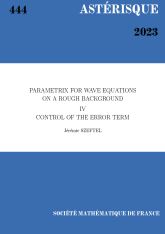Fibrés vectoriels hermitiens et groupes d'extensions sur les schémas arithmétiques II. La e d'Atiyah arithmétique
Hermitian vector bundles and extension groups on arithmetic schemes II. The arithmetic Atiyah extension
- Consulter un extrait
- Année : 2009
- Tome : 327
- Format : Électronique
- Langue de l'ouvrage :
Anglais - Class. Math. : 14G40; 11J95, 14F05, 32L10
- Pages : 361-424
- DOI : 10.24033/ast.864
Dans un précédent article, nous avons défini des groupes d'extensions arithmétiques dans le contexte de la géométrie d'Arakelov. Dans le présent travail, nous introduisons un analogue arithmétique de l'extension d'Atiyah ; sa e dans un groupe d'extensions arithmétiques convenable définit la e d'Atiyah arithmétique. Plus précisément, pour tout fibré vectoriel hermitien $\overline {E}$ sur un schéma arithmétique $X$, sa e d'Atiyah arithmétique $\widehat {{\rm at}}_{X/{\mathbb Z}}(\overline {E})$ appartient au groupe $\widehat {\rm Ext}^1_X(E,E\otimes \Omega _{X/{\mathbb Z}}^1)$ et constitue une obstruction à l'algébricité sur $X$ de l'unique connection unitaire sur la fibré vectoriel $E_{\mathbb C}$ sur la variété complexe $X({\mathbb C})$ qui soit compatible avec sa structure holomorphe. Dans les premières sections de cet article, nous présentons la construction et les propriétés de base de la e d'Atiyah, qui permettent notamment de définir des es caractéristiques en cohomologie de Hodge arithmétique. Nous étudions ensuite l'annulation de la première e de Chern $\hat c_1^H(\overline {L})$ d'un fibré en droites hermitien $\overline {L}$ dans le groupe de cohomologie de Hodge arithmétique $\widehat {\rm Ext}^1_X({\mathcal O}_X,\Omega _{X/{\mathbb Z}}^1)$. La détermination de tels fibrés en droites hermitiens se traduit en une question de géométrie diophantienne, concernant les points rationnels de l'extension vectorielle universelle de la variété de Picard de $X$. Nous étudions ce problème — qui a déjà été considéré, et résolu dans certains cas, par Bertrand — au moyen d'un ique résultat de transcendance dû à Schneider et Lang, et nous en déduisons un théorème de finitude sur le noyau de $\hat c_1^H$. Dans la dernière section, nous étudions un analogue géométrique de la situation arithmétique précédente. A savoir, nous considérons une variété projective lisse $X$ fibrée sur une courbe $C$, au dessus d'un corps de base $k$ de caractéristique nulle et nous attachons à tout fibré en droites $L$ sur $X$ sa e d'Atiyah relative ${\rm at}_{X/C}L$ dans $H^1(X,\Omega ^1_{X/C})$. Nous déterminons quand cette e ${\rm at}_{X/C}L$ s'annule. Notamment, lorsque la variété de Picard relative de $X$ sur $C$ n'a pas de partie fixe, cela se produit précisément lorsque une puissance non-nulle de $L$ descend en un fibré en droites sur $C$.


